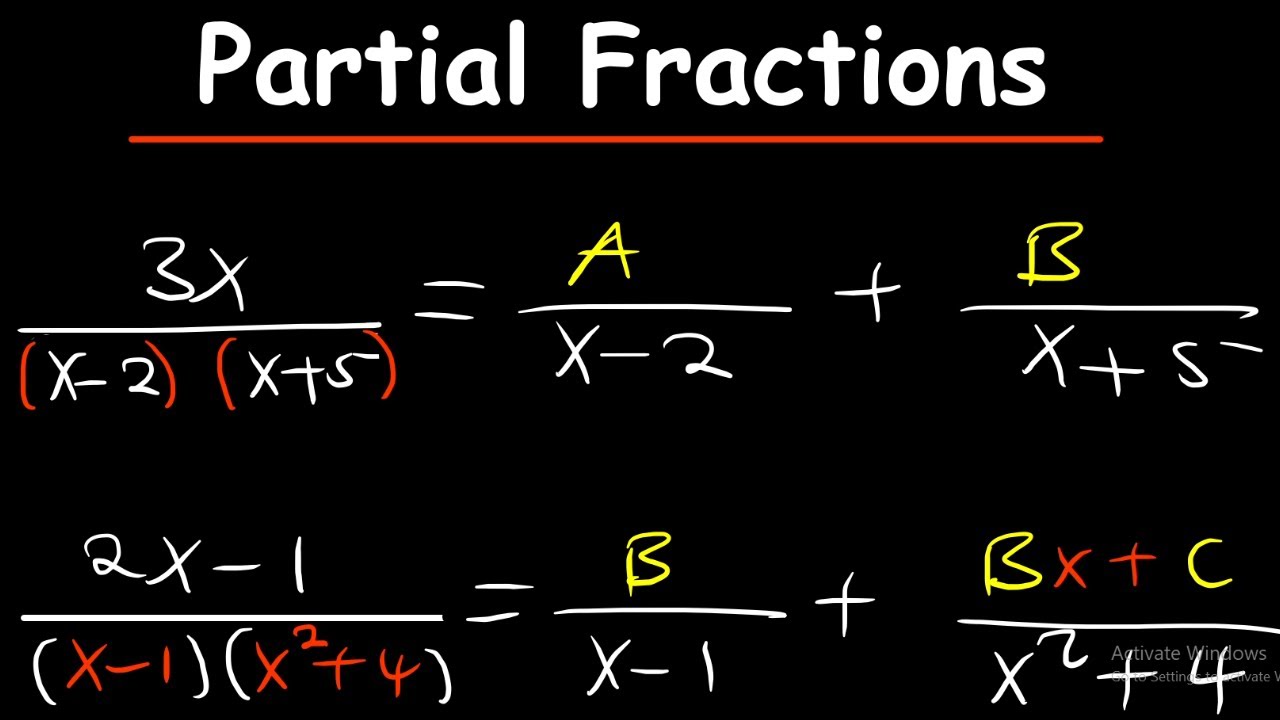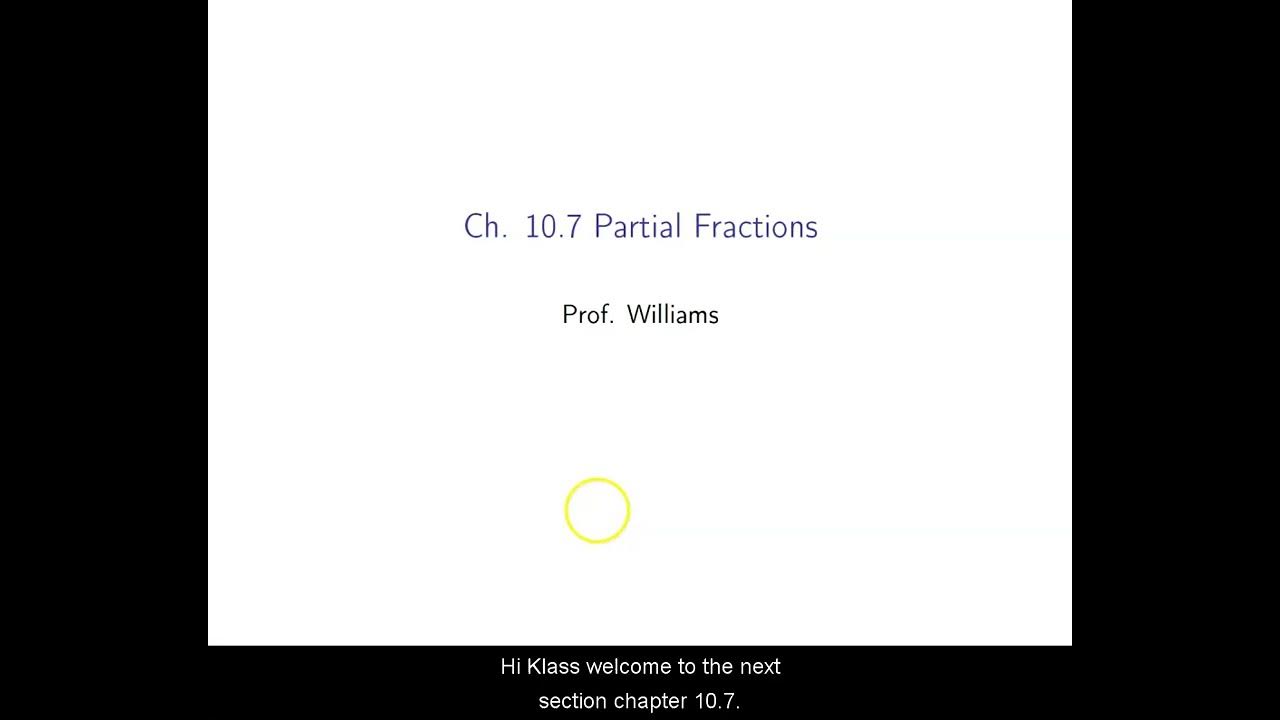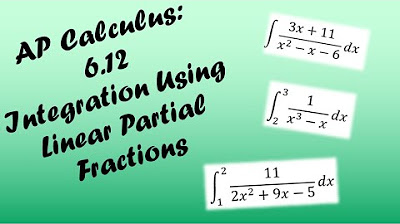Cover-Up Method for Partial Fraction Decomposition
TLDRThis video tutorial introduces the 'cover-up method' for partial fraction decomposition, a technique applicable to non-repeated linear factors. It demonstrates the process through examples, showing how to simplify complex fractions by equating coefficients and solving for unknowns. The method is efficient, skipping the need to clear the denominator entirely, and is particularly useful in calculus courses, making problem-solving quicker and more straightforward.
Takeaways
- 🔍 The video discusses the cover-up method for partial fraction decomposition.
- ℹ️ The cover-up method works on non-repeated linear factors, such as ax + b to the first power.
- ➗ The example used starts with a partial fraction decomposition of 3x - 4 over (x - 3)(2x + 1).
- 🧮 Traditional method involves clearing the denominator, expanding, and equating coefficients.
- 📊 Using the system of equations, values for A and B are determined as 5/7 and 11/7 respectively.
- 🔄 The cover-up method simplifies the process by focusing on individual factors and substituting their zeros.
- ✅ By letting x equal the zero of a factor, one can solve for the corresponding variable directly.
- 🚀 The method is faster and more efficient, especially with multiple linear factors.
- 📉 The video provides multiple examples to illustrate the method, including one with three factors.
- 💡 The cover-up method is useful in calculus, especially in Calc BC courses, for simplifying complex fraction decomposition problems.
Q & A
What is partial fraction decomposition?
-Partial fraction decomposition is a method used in calculus to break down a complex rational function into simpler fractions, making it easier to integrate or differentiate.
What is the cover-up method?
-The cover-up method is a specific technique within partial fraction decomposition that simplifies the process by strategically multiplying and substituting values to isolate and solve for unknown coefficients.
What are non-repeated linear factors?
-Non-repeated linear factors are terms in the denominator of a rational function that are of the form ax + b, where a and b are constants, and the factor is not repeated.
Why is the denominator always in factored form in partial fraction decomposition?
-The denominator must be in factored form to ensure that each term can be decomposed into a simple fraction, which is necessary for the application of the cover-up method.
How does the cover-up method simplify the process of solving for unknowns in partial fraction decomposition?
-The cover-up method simplifies the process by allowing you to multiply by a specific factor and then substitute a value for x that zeroes out all but one term, making it easy to solve for the unknown coefficients without expanding and equating coefficients.
What is the first step in applying the cover-up method?
-The first step is to ensure the denominator of the rational function is in factored form and then to multiply the entire equation by one of these factors.
How do you choose the value of x to substitute in the cover-up method?
-You choose a value of x that zeroes out the factor you are currently focusing on, which simplifies the equation to a point where you can easily solve for the unknown coefficient.
What is the purpose of covering up terms in the cover-up method?
-Covering up terms is a mental process to ignore certain parts of the equation that do not involve the unknown coefficient you are solving for, making it easier to focus on the relevant part of the equation.
Can the cover-up method be used with repeated linear factors?
-The cover-up method is primarily used with non-repeated linear factors. It may not be as straightforward with repeated factors, which require a different approach.
What is the final step in the cover-up method after solving for all unknowns?
-The final step is to substitute the solved values of the unknown coefficients back into the original equation to confirm that the decomposition is correct and to verify the result with a calculator if necessary.
Outlines
📚 Introduction to the Cover-Up Method in Partial Fractions
The video discusses the cover-up method for partial fraction decomposition, which is effective for non-repeated linear factors. The explanation begins with a standard example, showing how to decompose a rational expression into partial fractions by solving for unknowns A and B. The instructor details the process, including clearing the denominator, expanding terms, and equating coefficients to find the values of A and B.
📝 Implementing the Cover-Up Method
The video transitions into a practical demonstration of the cover-up method, using the same example. Instead of fully clearing the denominator, the method simplifies the process by selectively clearing factors and substituting convenient values for x to quickly find the coefficients. This method, as shown, can streamline solving for A and B, providing the same results as the longer traditional method.
Mindmap
Keywords
💡Partial Fraction Decomposition
💡Cover-up Method
💡Non-repeated Linear Factors
💡Coefficients
💡System of Equations
💡Common Denominator
💡Factored Form
💡Substitution
💡Equating Coefficients
💡Integration
💡Zero of a Factor
Highlights
Introduction to the cover-up method for partial fraction decomposition.
Explanation of non-repeated linear factors, such as ax + b.
Demonstration of the cover-up method on a simple rational expression.
Clearing the denominator to simplify the equation for unknowns.
Expanding and rearranging terms to compare coefficients.
Solving the system of equations for the coefficients a and b.
Substituting values of a and b back into the original equation.
Using a calculator to confirm the results of partial fraction decomposition.
Revisiting the problem with the cover-up method for a different approach.
Making a clever substitution by setting X to the zero of a factor.
Solving for a by covering up and substituting X with 1/3.
Repeating the process to solve for b by setting X to -1/2.
Illustrating the cover-up method with a more complex example.
Solving for a by focusing on the factor 3x - 1 and substituting X with 1/3.
Determining the value of a and then solving for b with a similar method.
Applying the cover-up method to find the value of c in a three-part fraction.
Finalizing the decomposition with values of a, b, and c.
Highlighting the efficiency of the cover-up method in calculus courses.
Encouraging the use of the cover-up method for quick problem-solving.
Transcripts
5.0 / 5 (0 votes)
Thanks for rating:





